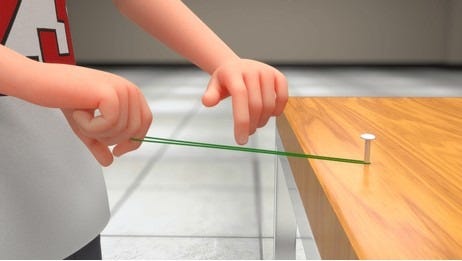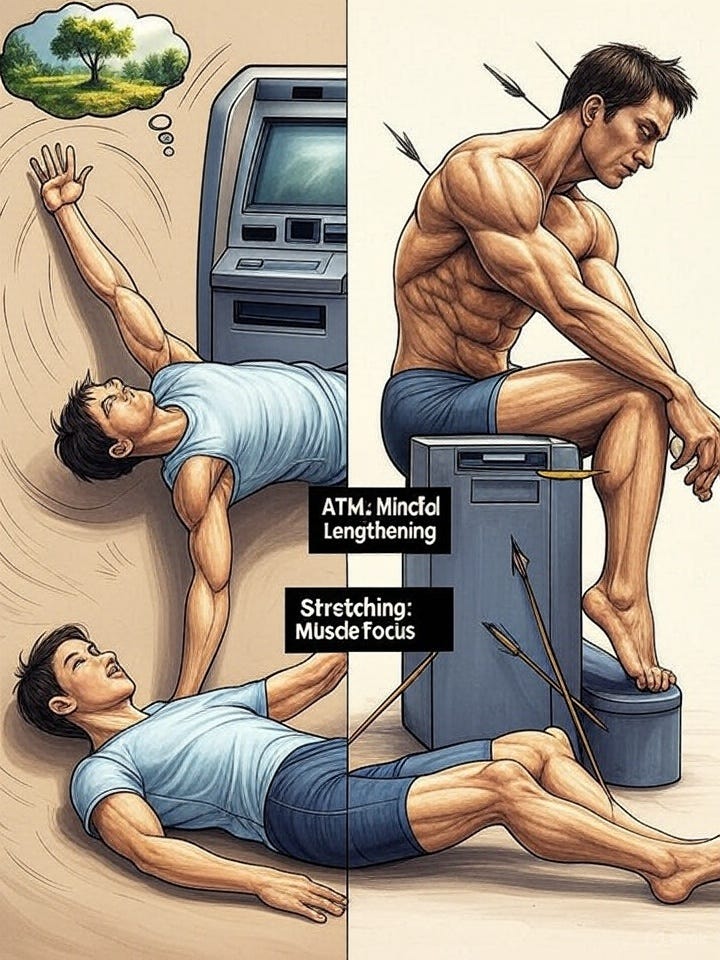I asked Grok again about the differences between lengthening and stretching to hear if it would come back with a different answer considering this is a different lesson. I found what it had to say about awareness most interesting:
Focus on Awareness vs. Muscle Elongation:
This ATM emphasizes mindful exploration of movement patterns and body connections. The goal is to enhance kinesthetic awareness—how body parts (arms, legs, pelvis, head) coordinate and interact—rather than solely targeting muscle stretch. Movements like pushing through the feet or extending arms are done to sense lengthening through the whole body, not just to stretch specific muscles.
Stretching Lessons primarily focus on elongating specific muscles or muscle groups to increase flexibility. The emphasis is often on reaching a maximum range of motion (e.g., touching toes to stretch hamstrings) with less attention to how the entire body contributes to the movement.
Dynamic and Integrated Movements vs. Static Holds:
This ATM involves dynamic, repetitive movements (e.g., rolling the pelvis, extending arms while pushing through feet) that engage multiple body parts simultaneously. These movements are fluid, encouraging the body to find ease and coordination rather than holding a position. For example, alternating between pushing through heels and balls of feet integrates the whole body in a flowing sequence. Whereas a stretching Lesson often includes static holds, where you maintain a stretched position for a set time (e.g., 30 seconds in a forward bend). The focus is on sustaining the stretch to lengthen muscle fibers, with less emphasis on movement or whole-body integration.
Mindful Exploration vs. Goal-Oriented Stretching:
ATM’s like this one encourage curiosity and self-observation, asking you to notice sensations like what presses into the floor or how far an arm extends. The lesson prioritizes discovering new movement possibilities and reducing effort, rather than achieving a specific range of motion. For instance, instructions to "compare differences between sides" foster awareness over performance. With stretching Lessons they are typically goal-oriented, aiming to increase flexibility or reach a specific position (e.g., splits). The focus is on outcomes, such as stretching further or holding a pose longer, rather than exploring how the movement feels or how the body organizes itself.
Breathing as a Movement Component vs. Secondary Focus:
ATM’s integrate breathing WITH movement, such as inhaling while filling the chest and drawing in the stomach. This enhances the sense of lengthening and supports relaxation and coordination, making breathing a central part of the movement process. With stretching lessons breathing is often secondary, used to relax into a stretch but not typically a primary focus. Instructions may include "breathe deeply," but the breath is not usually coordinated with dynamic movement patterns.
Neuromuscular Education vs. Physical Flexibility:
This ATM aims to educate the nervous system to improve movement patterns. By repeating small, mindful movements, the lesson helps the brain learn new ways to organize the body, leading to more efficient and effortless movement over time. The lengthening is a by-product of improved coordination. Stretching lessons on the other hand focus on physically lengthening muscles and connective tissues to improve flexibility. The primary goal is to change muscle length, with less emphasis on retraining the nervous system or altering movement habits.
Rest and Reflection vs. Continuous Effort:
Feldenkrais includes frequent pauses to rest and reflect, these breaks allow you to process sensations, compare sides, and integrate changes, reinforcing the lesson’s focus on awareness and ease. Typically, lessons specifically for stretching involve continuous effort, moving from one stretch to the next with minimal rest. Reflection is less emphasized, as the focus is on completing the stretching sequence.
I asked Grok to provide an image illustrating these differences, this is what it came up with:
My concerns about AI taking over the world are at this stage very small.
THIS crossed my stream after I posted today’s lesson…
more on “stretching”… and, although I’m not quite sure what that ‘flossing’ thing is he speaks of - nor those movements he’s doing at the end - I’m posting it because of what he says about the space between joints - which is totally relevant to what we’ve been learning)
So there’s some differences to contemplate as you move through tonight’s lesson. Enjoy learning more with, for and about your Self through tonight’s movements:
Keep reading with a 7-day free trial
Subscribe to MySelf.Study to keep reading this post and get 7 days of free access to the full post archives.





